Rob Powers is the new head of the restructured LightWave 3D Group. NewTek announced in August that it had created a new LightWave division based in Burbank, California. The new division was tasked with focusing on delivering visualization and 3D products for a range of industries from architecture, CAD and product development to advertising, game development and feature films. The former NewTek VP and Head of 3D Development Rob Powers was promoted to President of that new LightWave 3D Group. We decided to sit down with Powers and discuss his view on the company and the product moving forward.

There is no doubt Powers has an amazing energy and passion for LightWave. At SIGGRAPH in LA the NewTek booth was at the front of the main hall and one could not help but notice the sheer unrelenting energy of Powers – on the booth every day – discussing LightWave. He was and is a one man act of nature when it comes to getting LightWave out and into a wider audience.
For more than two years, Powers has lead the development and implementation of many new features in NewTek LightWave, first in version 10 and then this year in version 11 (11.5 is in beta now). The company is relying on a new marketing team (such as Dominick Spina, ex-NVIDIA) coupled with a host of new features such as VPR (Virtual Preview Renderer), anaglyph stereoscopic 3D preview, advanced flocking, instancing, workflow improvements and interchange support such as with ZBrush.

Prior to joining NewTek, Powers worked with James Cameron, serving as animation technical director and virtual art department supervisor for Avatar, and as CG supervisor for Aliens of the Deep. Powers also worked with Steven Spielberg and Peter Jackson as virtual art department supervisor for The Adventures of Tintin. He worked on Disney’s Honey I Shrunk the Kids and Jet Li’s The One, and interestingly, he was the lead animator of the famous 3D dancing baby on Ally McBeal!
We started by asking about the new much stronger presence at SIGGRAPH and his tour de force on the booth each day. “Being onstage for three days took a lot of energy, but I wanted to articulate all of the great things about LightWave because they had not been particularly articulated well prior, and I wanted the online viewers watching our live stream to see the great work from our studio users and hear first-hand why LightWave is a tool that they rely on for their projects.” he replied.
The new company that has been formed is still owned fully by NewTek. The main company NewTek, Inc. is however based in San Antonio, Texas and LightWave will now be headquartered in California (but with developers in Australia, New Zealand, Japan, Italy, France, Finland, and Austria – in addition to the US). NewTek was founded in 1985, actually in Kansas by Tim Jenison, a pioneer of desktop video, who Powers admires greatly for his vision in putting technology into the hands of a wider audience. In 1985 when NewTek first appeared at NAB with the Video Toaster it was unbelievably affordable and created an enormous storm. “I think Andy Warhol even used (NewTek tools),” says Powers. “Jenison is an amazing individual.”
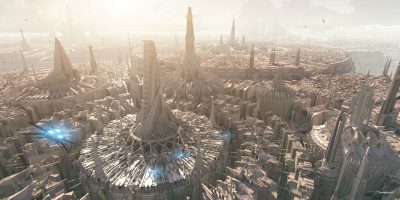
Some have wondered if the restructure was a precursor to a sell-off – especially in light of the Luxology (Modo)/Foundry merger. Companies are often packaged like this prior to sale, a point we put to Powers, who emphatically denied the rumor. “That has nothing to do with reality, we are very strongly interested in keeping the independence of the company. There are great things about a company being privately owned. I don’t know the future of everything, but I know I speak to the owner Tim Jenison regularly and the CEO, and we are like minded in that we love having the freedom of being an independent company.”
The restructuring has led to increased staffing and increased funding, the company has not been restructured as a cost cutting exercise. “It means that all the LightWave resources go into one focus out of Burbank,” says Powers.

When asked who the product is targeted at, Powers describes someone who wants ownership of the image, someone who likes to see the image from start to finish. And while the company has reached out to products like ZBrush (as LightWave does not have a comparable sculpting tool), Powers says the focus for the product has to be as a tool for smaller shops or single operators – who want to run the entire pipeline. LightWave has always been strong in the one man shop business. LightWave is for the person who wants to do it themselves – rather than be part of a vast highly compartmentalized specialist pipeline. “It does everything you need to do – to get your story told,” Powers explains.
The key customer for LightWave is someone who is both storyteller and hands-on artist. Key users such as Chris Jones (Australia) and Richard Mans (New Zealand) both pointed to as “amazing individuals, brilliant and talented” who are “perfect examples” of people producing incredible imagery, but who are normally just working as a single artist. “The fact that our tool can be used to facilitate that is the most exciting part of my job,” Powers adds.
LightWave also ships a GoAE option for export to Adobe AE. One might think that AE is a natural fit for LightWave, but Powers points out that although “we just LOVE Adobe products, we use them, but After Effects has not been so super strong in its 3D support. When you look at a product like Nuke that loads in FBX with 3D cameras automatically, we have done such a great job with our FBX importer and exporter, in fact a lot of the companies we have worked with have said it works perfectly. Digital Fusion also has a strong 3D application built in already – so GoAE is not saying we prefer that (AE), but there was a good opportunity to enhance that opportunity to work with AE – to make a good workflow stronger.”
New in the software
Genoma
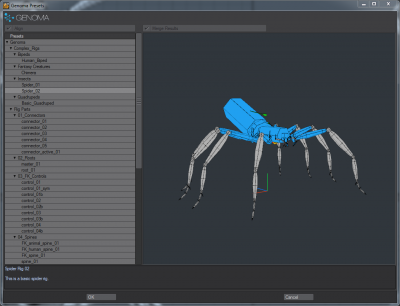
With LightWave 11.5 the product has a new modular instant-rigging system that can be used to quickly rig a simple biped or quadruped for animation in Modeler without the need for specialized rigging tools. There are also preset rigs of skeletal parts such as spines, wings, arms, legs, hands and feet. “Let’s be honest, at this point on the CG timeline, we kind of know how a biped rig works,” says Powers. “Defining the rigging standard for an animation package allows an ecosystem to grow around that standard and Genoma is our move in that direction. The Genoma project is led by Lino Grandi who I met after Tim Jenison introduced us. Lino is an award winning character animator and rigger from Italy and after our first meeting I knew that I wanted to add him to the LightWave team. We have been working on Genoma for some time – to provide a solution for people who might struggle to get a character rigged or even inject motion capture into a rig – it makes it a much simpler process. And that was the goal of this, so users don’t have to waste time re-creating complex rigs on every project. They should be able to take advantage of these preset rigs and not be forced to figure it out and set all that up every single time.”
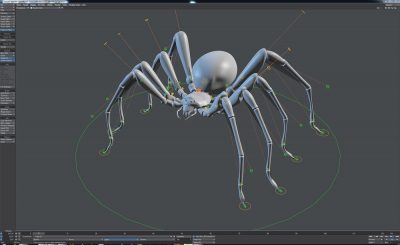 Powers also points out that Genoma includes standardized rigs and standardized rig parts – with all the complexity built in – “it has all the complexity – it comes with the same IK rig that I myself have been using but it is even further enhanced.”
Powers also points out that Genoma includes standardized rigs and standardized rig parts – with all the complexity built in – “it has all the complexity – it comes with the same IK rig that I myself have been using but it is even further enhanced.”
Modeling tools

New functionality has been added to the Modeler. LightWave 11.5 introduces many new tools such as Place Mesh, and Thicken. “I read the forums,” says Powers, “I know people were concerned that we are not going to focus on our modeling tools, but we have been laying out our architecture to allow new tools. These new tools are just the tip of the iceberg – the things we are looking at internally at the development meeting are very exciting – yet even the tools we have today are great.”
Instances
Instancing appeared prior to 11.5 but it has been enhanced with per instance control, and more randomization, – all based on user feedback – and not just from studios. Powers is at pains to point out “our internal beta group has been expanded, we have actively gone out and gotten people (for our beta group) from gaming, from print/magazines and architectural – even medical visualization.”
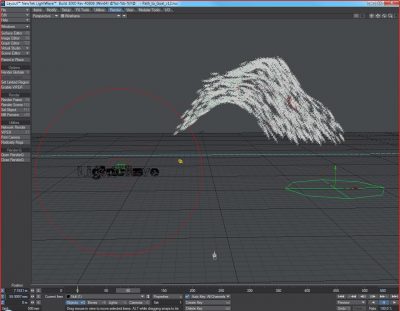
Animation/flocking
A specialized particle system is included that allows items to move in very organic ways, flocking offers “great new prey and predator behaviors that allow flocks to chase other flocks or have flocking agents seek out and chase the closest prey,” says Powers. Neutral flocks do not chase or chase but still affect other agents for collision avoidance. This area also allows for pre-sets.
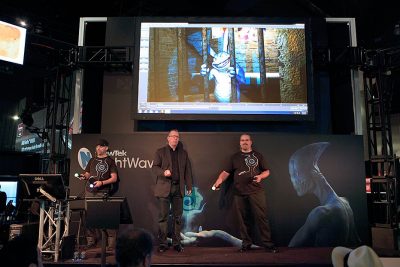
Virtual studio tools
One of the big hits at SIGGRAPH was the LightWave demo of their Virtual Studio Tools. If you connect LightWave with a PlayStation 3, “you can have the virtual camera working in real time in LightWave controlling a 3D light and puppeteering a character in real time, and record those takes,” ” explains Powers. “To me that is amazing, and the crowds at SIGGRAPH proved that. We had to add extra demos.” These tools could be used for character work but equally for an architectural walk through or virtual location scout – all recorded in real time.
Bullet dynamics
LightWave until recently did not have a robust built-in dynamics system. Building on some work done in LightWave 10, the company has implemented a Bullet dynamics system, but Powers claims the LightWave implementation keeps the user experience simple and very fast at the user interface. For example, he says, “if you shatter a piece of glass in some applications you will generate for every little piece of glass a new node in that tree. If you model a piece of glass (in LightWave) and use our fracture tool, the user can interact with it as if it is a single piece of glass – in the way you would in the real world. You just move that glass into LightWave – perform the dynamics on it, and the Bullet system in LightWave will go in and figure out all the separate pieces it has to shatter into, but without the overhead of that cluttering the scene graph. Once you have done that you save it as one object, but our Bullet dynamics will see it as millions of pieces without you having to see millions of nodes in your scene. It is a really powerful workflow that has proven valuable time after time in my own – as I did not have to deal with all the data management – I could focus on the artistic motion of the shot.”
Rendering
The company has added a VPR renderer for quick interactive rendering. Motion blur and depth of field are consistent across preview and final rendering. The product has a unified sampling system, “what that really does – in the past you had to make guesses about the sampling – unified sampling simplifies the process so they can be more specific about where they want the samples to be used. If you feel like you need sampling you don’t just need to keep dialing up sampling, you get a better use of performance where you need it.”
LightWave was the first commercial package to offer HDRi and global illumination – “the renderer has always been strong in that,” notes Powers. LightWave is continuing to try and “improve sampling, improve performance and optimize the renderer.”
Challenges
The product does face several challenges. Already faced with stiff competition from Cinema4D, the product must now face off with a cashed up modo from the combined Luxology-Foundry merger. The product is also only Windows and Mac – and does not support Linux – a common platform in larger sized facilities.
The company does not support Ptex. Powers was fairly circumspect about LightWave’s position on Ptex. The latest release improves with UV tools, with UV unwrap, . Powers concedes that up until now UV workflow has been a problem for LightWave and so for the time being they are focusing on making UV easier,
The company does not have full vector displacement. “We need to continue to work on that, and also our MIP map support are two areas that, I will be frank with you, are areas I am not completely happy with. Part of that is that we are working on updates to our rendering engine – and how it handles data – so that those formats can be used better,” he outlines.
LightWave does not seem to actively push users to third party renderers, open source initiatives such as Ptex or say OpencolorIO. For example, it is yet to adopt Alembic. But clearly third party renderers and standards like Alembic are of great interest and quite possibly on the internal development schedule.
Summary
LightWave is certainly moving out of a period of suffering from a lack of aggressive marketing, and being in the shadow of several other 3D applications aimed at the one-man, hard working, generalist. After years of being known primarily for its network TV episodic work, the LightWave community must welcome the push to gain wider acceptance and name/brand recognition. To really gain major influence it would seem LightWave needs to improve both its own renderer and work more closely with third party renderers. Photorealism combined with ease of use is driving the render market right now in ways that it hasn’t been pushed for a decade. LightWave has a new energy but even so it will need to build stronger bridges to help carry a dedicated user community to greater opportunities.

I’ve always preferred Lightwave’s interface over other 3D animation programs I’ve used. I’m excited to hear of these developments, especially GoAE. You don’t hear too much about Lightwave. Maybe we will in the future. Perhaps even an FXPHD class? 🙂
That’s AWESOME news about GoAE. I’m the perfect user for that combo….can’t wait to get my hands on it!
The Motion Theory : Buick Add was done in CInema 4D hahaha ! ! Check out the Casey Hupke NAB2012 live demo, he does a breakdown of the add. Thats definitely a “stiff competition”. Burn!!
Casey Hupke used C4D for the car, Jen Hachigian used Lightwave for the Ice skater.
\ 😛
Greetings. The Buick advertisement used three Cinema 4D artists (including Casey Hupke and Chris Riehl), and seven LightWave 3D artists (myself, Dave Bailey, Josh Hooker, John Neihuss, Anthony Ramierez, Neil Taneja, and Charles Paek). The full credits for this commercial are posted on Motionographer for those interested.
Cinema4D was used to deform the breakup of the car, to generate the particles surrounding the car, and to spawn After Effects motion graphics. However, the car itself was not rendered in Cinema4D. The Cinema4D deformations were exported as MDD files for rendering in LightWave. In addition to modeling/surfacing/rendering the car exteriors and interiors in LightWave, LightWave was used to render volumetric mists, the particles surrounding the ice skater, and the logo at the end of the commercial.
I too would love to see good lightwave 3d classes on FXPHD. I have used it for years and the training out there was from good to horrible. There are a few guys that do it well. Dan Ablan comes to mind. Would love to see more extensive training showing real world shots not just canned models for said classes.
CJ
What about Lightwave CORE???!!! What happened with that? That concept went dead! The guys at Newtek advertised the CORE architecture some years ago and now nobody is saying anything about it! One thing that Lightwave is missing is the integration of the modeler and layout modules. Without this integration some functions are hard to achieve, like CAMERA MAPPING for example, since you cannot have a camera in the environment in which you model. Another thing that was cool from the CORE concept was the ability to have parametrical history control over the modeling process, so you could go back in the history of your model and change the modeling parameters all along the way. How are the guys at Newtek are planning to address this issues of Lightwave??
Greetings. I have earned a living in the Los Angeles VFX industry since 1999 using mostly LightWave 3D.
In early 2010 I planned to leave LightWave because of my disappointment with CORE. However, Rob Powers took over LightWave development in mid-2010, and the advances LightWave has made since Rob took over are tremendous.
I’m staying with LightWave because it keeps up with my VFX needs, and I can still earn a good living from it. However, if LightWave does not provide the tools you need for your work, I encourage you to learn another generalist package like Cinema 4D or 3ds Max.